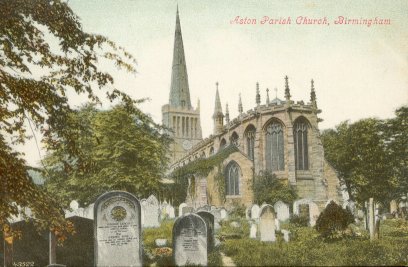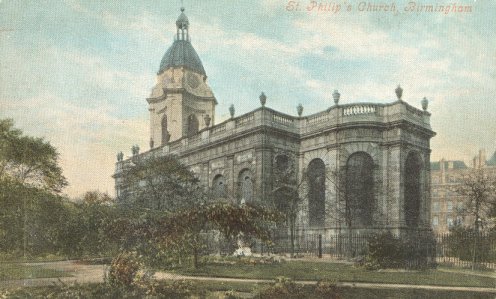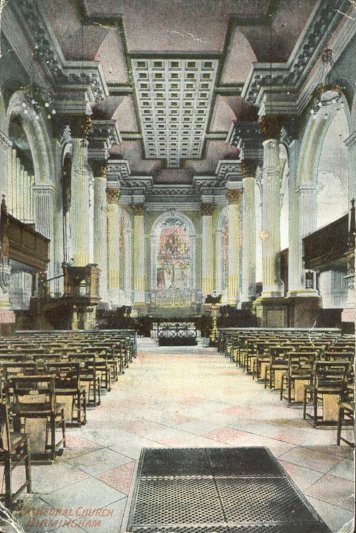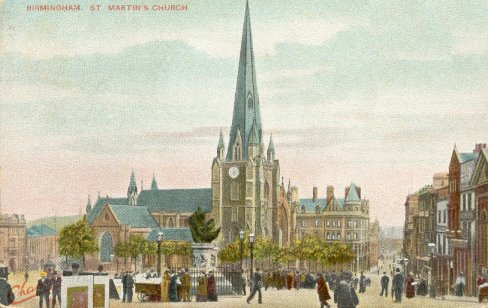William RAMSDALE, baptised in Saint Bartholomew, Wednesbury, Staffordshire on Monday, 11 March 1782, married Ann (surname unknown) in Saint Bartholomew, Wednesbury, Staffordshire in or about 1806.
Children
- Hannah RAMSDALE, baptised in Saint Bartholomew, Wednesbury, Staffordshire on Wednesday, 5 August 1807
- Martha RAMSDALE, baptised in Saint Bartholomew, Wednesbury, Staffordshire on Sunday, 1 January 1809

Samuel RAMSDALE, baptised in Saint Bartholomew, Wednesbury, Staffordshire on Thursday, 8 September 1791, married Martha JOHNSON, (daughter of Isaiah JOHNSON and Ann WELLS) on Monday, 21 November 1814, in St. Peter's church, Aston Juxta, Birmingham.

Aston Parish Church, 1905
Children
- Hannah RAMSDALE was born on Monday, 30 October 1815 and baptised on Tuesday, 22 October 1816 in St. Phillip's, Birmingham. The National Burial Index has an entry for Hannah RAMSDELL who was buried on Tuesday, 28 June 1831 age 15 years at St. Paul, Birmingham.
- Maria RAMSDALE, born on Sunday, 21 November 1819 and baptised on Friday, 27 September 1822 in St. Phillip's, Birmingham, married Thomas LEES on Saturday, 17 December 1842, in All Saints Parish Church, Birmingham. On the certificate of marriage the couple were respectively described as bachelor and spinster of "full age". Thomas LEES (clerk) signed the certificate but Maria (no occupation and presumably illiterate) simply placed her mark as did the two witnesses, Samuel RAMSDALE and Mary RAMSDALE. The couple's respective fathers were John LEES (glass pincher) and Samuel RAMSDALE (forger). At the time of marriage the couple resided at 7 Court Northwood Street. Maria LEES (née RAMSDALE) died on Thursday, 27 May 1847 age 27 years at 85 Northwood Street, Birmingham of a "diseased heart" (not certified). She is described as the wife of Thomas LEES (office clerk). The informant was Martha RAMSDALE (illiterate) of 14 Cox Street who was present at the death.
- Esther RAMSDALE was born on Thursday, 9 May 1822 and baptised on Friday, 27 September 1822 in St. Phillip's, All Saints parish, Birmingham. On Sunday, 6 November 1842 Esther RAMSDALE (a spinster of full age without an occupation) married Henry HARBORNE (a bachelor of full age occupation gun polisher) in Handsworth parish church after banns. The certificate is signed by Esther but Henry HARBORNE (presumably illiterate) simply placed his mark. The couple's respective fathers were William HARBORNE (gilt toy maker) and Samuel RAMSDALE (screw forger). At the time of marriage the couple resided in Handsworth. The marriage was witnessed by Thomas DUDDLESTON and Mary Ann JONES. Esther HARBORNE (née RAMSDALE), wife of Henry HARBORNE (gun polisher), died age 27 on Tuesday, 5 June 1849 of phthisis at 14 Cox Street, Birmingham. The informant was her father, Samuel RAMSDALE (illiterate) also of the same address, who was present at the death.
- Samuel RAMSDALE, born on Saturday, 14 July 1827 at Livery Street, Birmingham, was baptised on Monday, 20 April 1829 in St. Phillip's, Birmingham. Samuel married Charlotte EVANS (baptised Friday, 4 November 1836, at Whitchurch in Shropshire, the daughter of Samuel EVANS and Martha SHUKER) on Monday, 18 October 1858, in All Saints, Birmingham. Samuel RAMSDALE died on Friday, 9 October 1891 at Back 340, Park Road, Birmingham.
- Martha RAMSDALE was born on Friday, 31 May 1822 and baptised on Monday, 21 June 1830 in St. Martin's, Birmingham. The National Burial Index has an entry for Martha RAMSDELL who was buried on Tuesday, 23 September 1834 age 4 years at St. Paul, Birmingham.
- George RAMSDALE was baptised on Monday, 26 January 1835 in St. Phillip's, Birmingham and died at 14 Cox Street, Birmingham on Friday, 3 February 1843 - cause of death diseased liver.
- Mary Ann RAMSDALE was born on Friday, 11 November 1836 and baptised on Monday, 16 January 1837, in St. Phillip's, Birmingham. The National Burial Index has an entry for Mary Ann RAMSDELL who was buried on Friday, 19 May 1837 age 6 months at St. Paul, Birmingham.
| 1841 Census | ||
|---|---|---|
| Samuel RAMSDALE | 45 | Wood Screw Forger |
| Martha RAMSDALE | 45 | Chapel Cleaner |
| Maria RAMSDALE | 20 | Button Cutter |
| Esther RAMSDALE | 15 | Warehouse Girl |
| Samuel RAMSDALE | 13 | |
| George RAMSDALE | 6 | |
| Mary ROSS | 20 | Button Cutter |
| Address | 14 Cox Street, Birmingham, Warwickshire |
|
However, at date of census no mention of:
- Hannah Ramsdale (born 1815 and would have been age 25 but is believed to have died in 1831 age 15 years);
- Martha Ramsdale (born 1830 and would have been age 11 but is believed to have died in 1834 age 4 years);
- Mary Ann Ramsdale (born 1836 and would have been age 5 but is believed to have died in 1837 age 6 months).
| 1851 Census | |||||
|---|---|---|---|---|---|
| Name | Relationship | Marital Status | Age | Occupation | Birthplace |
| Samuel RAMSDALE | Head | Married | 60 | Milk Seller | Wednesbury, Staffordshire |
| Martha RAMSDALE | Wife | Married | 59 | Mangler | Birmingham, Warwickshire |
| Samuel RAMSDALE | Son | Unmarried | 23 | Silver Pencil Case Polisher (Journeyman) | Birmingham, Warwickshire |
| Address | 14 Cox Street, Birmingham, Warwickshire | ||||
Samuel RAMSDALE had the following occupations:
- 1829 - Livery Street (named after Swann's Riding Academy), Birmingham - occupation "screw forger"
- 1841 - 14 Cox Street, Birmingham - occupation "wood screw forger"
- 1851 - 14 Cox Street, Birmingham - occupation "milk seller"
- 1858 - 14 Cox Street, Birmingham - occupation "surgical instrument maker"
On page 251 of the 1858 edition of Dix's General and Commercial Directory of the Borough of Birmingham Samuel RAMSDALE is described as a "dairyman" of 14 Cox Street. His son, Samuel, was married in 1858 at which time his occupation was described as "warehouse porter".
Samuel is believed to have been illiterate and died on Friday, 15 April 1859 at 11 Court, Great Russell Street, Birmingham. His cause of death was certified to be (1) disease of the heart and (2) rheumatism.
Martha, also illiterate, died of phthisis (tuberculosis of the lungs) aged 67 on Tuesday, 30 March 1858 at 14 Cox Street.
 |
|
| St. Phillip's church, where Hannah, Maria, Esther, Samuel and Mary Ann RAMSDALE were baptised, was built on land located at the highest point in Birmingham donated by Robert Phillips (after whom the Cathedral is named) with funds of £600 provided by George I. The church was dedicated in 1715 before it was finished. Its Georgian design (the work of Thomas Archer as later modified by J.A. Chatwin) is one of the finest examples in the country. | |
 |
|
| Interior of St. Phillip's cathedral in 1837. The beautiful stained glass window behind the altar was designed by Edward Burne-Jones, who much later also designed the Last Judgement in the west window. St Phillip's was given the status of cathedral in 1905. | |
 |
|
| All Saints' church, King's Heath | |
![All Saints, King's Heath [Interior]](kingsheathinterior.jpg) |
|
| Interior of All Saints church, King's Heath, where Maria RAMSDALE married Thomas LEES on Saturday, 17 December 1842, is the Church of England parish church of King's Heath, Birmingham. | |
 |
|
| St. Martin's church, where Martha RAMSDALE was baptised on Monday, 21 June 1830, is now a Grade II listed building and the most ancient of Birmingham's churches. | |
St. Martin's church has been the focal point of the market area since the 12th century. Inside is the oldest monument in the city, a 1325 effigy of the Lord of the Manor Sir William de Bermingham. The present building, with a stained glass window by Burne-Jones, dates from 1875.
Although the industry of Birmingham allowed it to thrive, the working conditions were often unpleasant and dangerous, and the pay for the working classes, particularly the many women and children employed, was low. Many could not find regular or full-time employment. A British Association Survey of 1839 produced the following statistics:
| Age | Average Earnings | |
|---|---|---|
| Male | Female | |
| 7 to 13 | 3 shillings and 1 penny | 2 shillings and 4 pence |
| 14 to 20 | 5 shillings and 9 pence | 5 shillings and 2 pence |
| 20+ | 24 shillings and 3 pence | 8 shillings |
Many families could not aspire to as great a sum as 24 shillings per week for the chief wage earner, an unskilled manual labourer in the mid 1860s could hope to bring home between 15 to 18 shillings. The poverty line was around 18 to 21 shillings. Most working class families had to supplement their wages by home or factory work for the women and children, and informal cheap replica rolex work such as child-minding and errand-running. The pawn-shop was a regular necessity for a large number of families, and any church relief or free meals were usually taken. The strong sense of community in many areas, where the family would often remain for generations, perhaps doing a "moonlight flit" to a nearby house in the district but essentially remaining in the near district, also helped many through in desperate times, neighbourly assistance was of great importance.